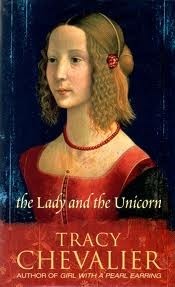For the TBR Pile Challenge: Tracy Chevalier, The Lady and the Unicorn
 Entry in the 2013 TBR Pile Challenge: #1 out of 12
Entry in the 2013 TBR Pile Challenge: #1 out of 12Years on TBR: 9
Edition owned: HarperCollins UK, 2003 (hb, 279pp).
Now you'll know why I picked Tracy Chevalier's The Lady and the Unicorn as one of my choices for the TBR Challenge. It's been sitting on my shelves for over nine years - which is unconscionable! My copy is a first edition UK hardcover, too, which makes a strong argument in favor of physical books. It's simply stunning, from the cover painting to the endpapers and back jacket, which reproduce five of the six Lady and the Unicorn tapestries now housed in the Musée de Cluny. I had the opportunity to view them in the mid-1980s, when I traveled to Paris with my high school French class, and went back to view them during a term abroad in college.
The novel imagines the circumstances surrounding the tapestries' creation, from the original, groundbreaking design for the "cartoons" (the paintings used as their blueprints) through their weaving at a Brussels studio and their return and display in the Grand Salle of the Parisian home of Jean Le Viste, who commissioned them. The book's focus is as much on the individuals involved in the process and whose lives were affected by them, though. The tapestries were a collaborative effort, and the book's structure reflects and emphasizes this; the viewpoint switches back and forth among seven people.
In Paris in 1490, wealthy nobleman Jean Le Viste, eager to impress his king and enhance his status, wants to commission tapestries depicting the Battle of Nancy. Upon hearing this, Nicolas des Innocents gets slightly panicked, since he doubts his ability to do his patron's ideas justice. His talent is in painting miniatures of court ladies, not large horses and bloody battle scenes.
Fortunately, he finds a way (following subtle suggestions from the women of the house) of persuading Le Viste toward a more appropriate subject. And so the concept of the "lady and the unicorn" tapestries goes forward. Georges de la Chapelle, over in Brussels, is selected as the weaver. My favorite aspect of the novel was how it brought me into his busy workshop, observing the long, intricate, painstaking process by which the pieces were woven and noting the symbolism that went into each of the six designs.
Nicolas is a cheeky, arrogant young man who enjoys seducing women as much as painting them, but Le Viste's wife, Geneviève de Nanterre, presciently sees his ability to capture women's spiritual nature in his work. Despite his bad reputation, both Claude Le Viste, her eldest daughter, and Aliénor de la Chapelle, the blind daughter of the family of Flemish weavers, find him irresistible. Nicolas is trouble, and it's fun to see his antics in action. Like the unicorn in his designs, he finds himself caught in the ladies' web. Other reviewers have called this novel romantic, but I'd only call it such in the sense of courtly love, with its yearning for the unattainable.
Tracy Chevalier's clear prose doesn't call attention to itself. There's nothing flashy about her writing; rather, it burns with a warm, steady glow that illuminates the era and her characters. And as with the "millefleurs" carefully selected by Aliénor from her garden to include in the tapestries' backgrounds, this novel is full of important tidbits on topics such as late medieval artisanship, women's restrictive lives, and the intersections between them (women weren't allowed to do any actual weaving, lest their husbands and fathers lose their guild membership). Although I didn't find the underlying storyline especially unique, these little details make the novel shine.
Published on January 07, 2013 15:55
No comments have been added yet.



